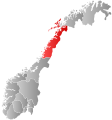Grane, Nordland
| Grane kommune | |||
|---|---|---|---|
| Municipality | |||
|
|||
 Grane within Nordland |
|||
| Coordinates: 65°24′2″N 13°30′38″E / 65.40056°N 13.51056°ECoordinates: 65°24′2″N 13°30′38″E / 65.40056°N 13.51056°E | |||
| Country | Norway | ||
| County | Nordland | ||
| District | Helgeland | ||
| Administrative centre | Trofors | ||
| Government | |||
| • Mayor (2003) | Bjørn Ivar Lamo (Ap) | ||
| Area | |||
| • Total | 2,004.15 km2 (773.81 sq mi) | ||
| • Land | 1,883.44 km2 (727.20 sq mi) | ||
| • Water | 120.74 km2 (46.62 sq mi) | ||
| Area rank | 30 in Norway | ||
| Population (2011) | |||
| • Total | 1,487 | ||
| • Rank | 366 in Norway | ||
| • Density | 0.8/km2 (2/sq mi) | ||
| • Change (10 years) | -7.7 % | ||
| Demonym(s) | Graneværing | ||
| Time zone | CET (UTC+1) | ||
| • Summer (DST) | CEST (UTC+2) | ||
| ISO 3166 code | NO-1825 | ||
| Official language form | Neutral | ||
| Website | www |
||
|
|
|||
![]() Grane is a municipality in Nordland county, Norway. It is part of the Helgeland traditional region. The administrative centre of the municipality is the village of Trofors. There are several other villages including Fallmoen, Leiren, Majavatn, and Strendene. European route E06 highway and the Nordland Line run through the municipality from south to north.
Grane is a municipality in Nordland county, Norway. It is part of the Helgeland traditional region. The administrative centre of the municipality is the village of Trofors. There are several other villages including Fallmoen, Leiren, Majavatn, and Strendene. European route E06 highway and the Nordland Line run through the municipality from south to north.
The municipality of Grane was established on 1 July 1927 when it was separated from the large municipality of Vefsn. Initially, Grane had 1,746 residents. The municipal boundaries have not changed since then.
The municipality (originally the parish) is named after the old Grane farm ("Grane" 1661), since the first church was built there in 1860. The name Grane is pronounced with a long a and short n, which is not palatalized. It is seemingly a simple and plain name, but many questions arise regarding both valid meanings for the word and the spoken forms it takes. The spoken form is most peculiar. It is distinct from other genuine old farm names in the area in that it is uninflected, with no definite form and consequently no distinct case (neither dative nor genitive). It is said short and crisp, regardless of what speech context it is found in.
...
Wikipedia


